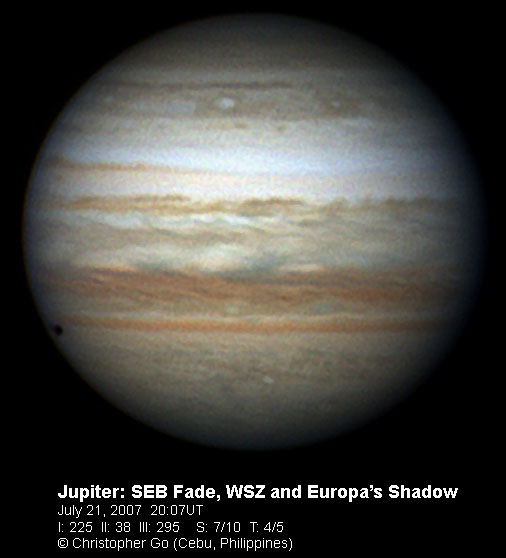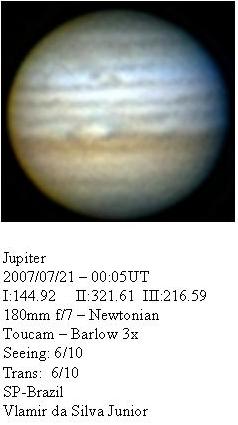د ALPO-Japan Latest

Jupiter Image 2007/07/21(UT)
¢vÃxv
Carlos.E.Hernandez,Christopher Go,Vlamir da Silva Junior,Antonello Medugno,Carmelo Zannelli
Carlos.E,Christopher Go,V.da Silva Jr.,A.Medugno,T.Akutsu,C.Zannelli
|
Carlos E. Hernandez (Drawing:9-inch (23-cm) F/13.5 Maksutov- Cassegrain) |
I made an observation of Jupiter on July 21,2007 (04:20 U.T.) under average seeing conditions (6/10).
The region between the South Equatorial Belt (SEB),Equatorial Zone (EZ),and North Equatorial Belt (NEB)
was very chaotic. The Great Red Spot (GRS) was prominent following the CM. I welcome any comments that you
may have on my observation.
Date (U.T.): July 21,2007
Time (U.T.): 04:20
L1 300.0,L2 115.3,L3 012.3
Instrument: 9-inch (23-cm) F/15 Maksutov-Cassegrain
Magnification: 273x
Filters: None (IL)
Seeing (1-10): 6,Antoniadi (I-V): III
Transparency (1-6): 4-5
Notes:
South Polar Region (SPR): Appeared dark to dusky (3-4/10) and mottled.
South Temperate Zone (STZ): Appeared thin and bright (7/10).
South Temperate Belt (STB): Appeared thin and dark to dusky (3-4/10). No ovals noted at this time within it.
South Tropical Zone (STrZ): Appears bright (7/10) and contains the Great Red Spot (GRS) and a dull (5/10) band following the GRS.
Great Red Spot (GRS): Appears dusky to dull (4-5/10) with a dark (3/10) center. I was unable to time it as a tree blocked my view.
South Equatorial Belt (SEB): Appears irregular,especially preceding the Great Red Spot (GRS). The portion of the SEB preceding the
GRS appears dark to dull (3-5/10) over it's northern half whereas dusky (4/10),isolated condensations are noted along the
typical southern border of the SEB. The SEB following the GRS appears dark to dusky (3-4/10) containing bright (7/10)
ovals/rifts within it.
Equatorial Zone (EZ): Appears shaded to bright (6-7/10) and contains a band (EZB) across it's midsection. Blue festoon projections
(from blue festoons along the NEB-S) are also noted within it.
North Equatorial Belt (NEB): Appeared dark to dusky (3-4/10) with a bright (7/10) rift originating preceding the CM (over the southern
border) and extending towards the following limb. Two blue festoon bases were noted along the southern border of the NEB.
North Temperate Belt (NTB): Appears north of the NEB as broad,dusky (4/10) band.
North Polar Region (NPR): Appears dark to dull (3-5/10) and mottled.
 [Carlos.E. Hernandez South Florida U.S.A ]
[Carlos.E. Hernandez South Florida U.S.A ]
|
Christopher Go (Celestron C11) |
The sky was mostly cloudy this evening. Seeing was good though and I was able to scrape a few images.
The SEBs is very faded!! Note the tiny white spot at the western side of the faded SEB. Note the dark bar at the S3TB. A FFR is also visible at the SSTB between the white spots. Note the bright area at the STB rising on the right. It is also interesting to note that the eastern half of the SEBn in this image has the same color as the EZ!!
The EZ is still very busy here with a lot of festoon activity. The NEB is dark red. The White Spot Z (WSZ) is still visible but it is more of a dark spot now than white. The NTB is very bright red. Europa's shadow is the dark spot north of the NTB.

[Christopher Go : Cebu Philippines]
|
Vlamir da Silva Junior (180mm Newtonian) |
In this photo we can see the STrD-1.
It has already passed the CM.
We can hardly see the Red-Jr almost in the western limb.
 [Vlamir da Silva Junior : Sao Paulo,Brazil]
[Vlamir da Silva Junior : Sao Paulo,Brazil]
|
Antonello Medugno (356mm SC) |
2007/07/21 - UT: 19:18.2
Meade 14" (356mm) LX200 GPS (SC) efl=5700
Filters: G & B (Astronomik) R+IR=Wratten #25 (Baader)
Camera: ImagingSource DMK21AF04.AS mono @ 13ms
Seeing 5/10,Trans.: 2/5
Comments: The recirculating dark spots are well visible.
 [Antonello Medugno,Capua-Italy]
[Antonello Medugno,Capua-Italy]
|
Tomio Akutsu (280mmSC C11) |
 áCebu PHILLIPINES ¢vÃxvâ
áCebu PHILLIPINES ¢vÃxvâ
|
Carmelo Zannelli (235mm SC ) |
Here my last Jupiter image under fair seeing conditions but dense haze
over the city....
 [Carmelo Zannelli,Sicily-Italy]
[Carmelo Zannelli,Sicily-Italy]


[Carlos.E. Hernandez South Florida U.S.A ]

[Vlamir da Silva Junior : Sao Paulo,Brazil]
[Antonello Medugno,Capua-Italy]
áCebu PHILLIPINES ¢vÃxvâ
[Carmelo Zannelli,Sicily-Italy]
 ALPO-Japan Latest
ALPO-Japan Latest

 Jupiter Section
Jupiter Section